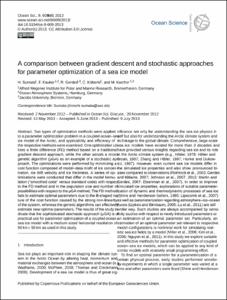A comparison between gradient descent and stochastic approaches for parameter optimization of a sea ice model.

View/
Average rating
votes
Date
2013Author
Sumata, H.
Kauker, F.
Gerdes, R.
Koeberle, C.
Karcher, M.
Metadata
Show full item recordAbstract
Two types of optimization methods were applied to a parameter optimization problem in a coupled ocean-sea ice model of the Arctic, and applicability and efficiency of the respective methods were examined. One optimization utilizes a finite difference (FD) method based on a traditional gradient descent approach, while the other adopts a microgenetic algorithm (mu GA) as an example of a stochastic approach. The optimizations were performed by minimizing a cost function composed of model-data misfit of ice concentration, ice drift velocity and ice thickness. A series of optimizations were conducted that differ in the model formulation (smoothed code versus standard code) with respect to the FD method and in the population size and number of possibilities with respect to the mu GA method. The FD method fails to estimate optimal parameters due to the ill-shaped nature of the cost function caused by the strong non-linearity of the system, whereas the genetic algorithms can effectively estima.....
Resource URL
https://os.copernicus.org/articles/9/609/2013/Journal
Ocean ScienceVolume
9Issue
Article 609Page Range
pp.609-630Document Language
enSustainable Development Goals (SDG)
14.2Maturity Level
Pilot or DemonstratedSpatial Coverage
Arctic OceanDOI Original
https://doi.org/10.5194/os-9-609-2013Citation
Sumata, H., Kauker, F., Gerdes, R., Köberle, C. and Karcher, M. (2013) A comparison between gradient descent and stochastic approaches for parameter optimization of a sea ice model. Ocean Science, 9:609, pp.609–630. DOI: https://doi.org/10.5194/os-9-609-2013Collections
- CAPARDUS Practices [147]
The following license files are associated with this item:
 Repository of community practices in Ocean Research, Applications and Data/Information Management
Repository of community practices in Ocean Research, Applications and Data/Information Management
